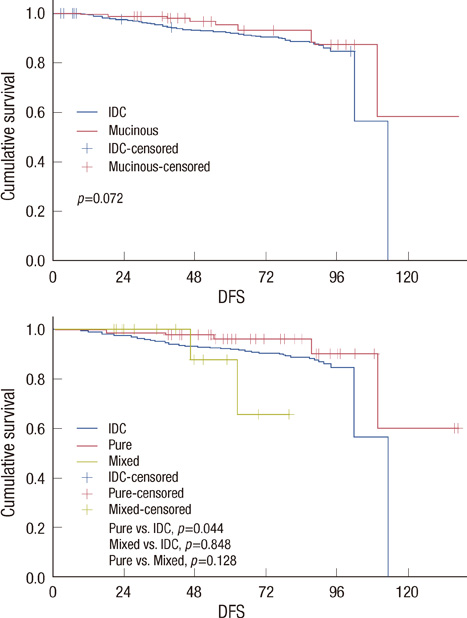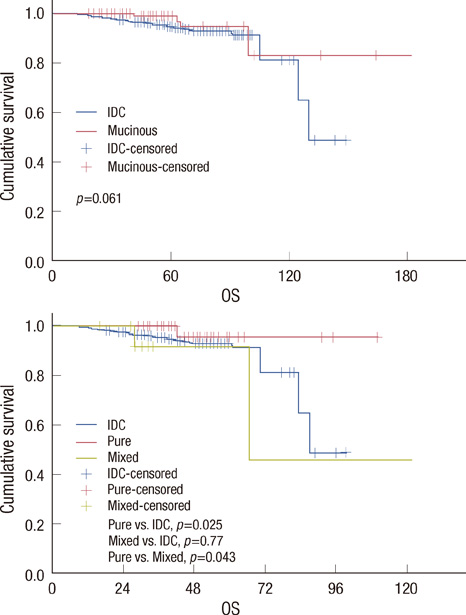Mucinous Carcinoma of the Breast in Comparison with Invasive Ductal Carcinoma: Clinicopathologic Characteristics and Prognosis
- Affiliations
-
- 1Department of Surgery, Konkuk University Medical Center, Konkuk University School of Medicine, Seoul, Korea.
- 2Department of Surgery, Samsung Medical Center, Sungkyunkwan University School of Medicine, Seoul, Korea. jeongeon.lee@samsung.com
- KMID: 2175726
- DOI: http://doi.org/10.4048/jbc.2011.14.4.308
Abstract
- PURPOSE
Mucinous carcinoma (MC) of the breast is a rare histologic type of mammary neoplasm. The objective of this study was to evaluate the long-term disease-free survival (DFS) and overall survival (OS) of MC.
METHODS
We conducted a retrospective analysis of all MC cases reported to a database between 1994 and 2010. Clinicopathological characteristics and survival of 268 MC cases were reviewed and compared with 2,455 invasive ductal carcinoma-not otherwise specified (IDC-NOS) cases.
RESULTS
The MC cases were of a younger age, involved less lymph nodes, lower stage, more expression of hormonal receptors, and less HER2 overexpression compared to the IDC-NOS cases. The 5-year DFS rate for MC was 95.2% compared to 92.0% for IDC-NOS. The 5-year OS rate for MC was 98.9% compared to 94.9% for IDC-NOS. Multivariate analysis using Cox regression revealed that the mucinous type was a significant prognostic factor for DFS with lower nodal status (N stage) and hormonal therapy. For OS, only N stage was the most significant prognostic factor followed by adjuvant chemotherapy and adjuvant hormonal therapy.
CONCLUSION
MC was shown to be associated with a better DFS than IDC-NOS, but it had a similar OS. Nodal status and adjuvant therapy appear to be more significant predictors of prognosis than histologic subtype.
Keyword
MeSH Terms
Figure
Cited by 4 articles
-
Human Epidermal Growth Factor Receptor 2-positive Mucinous Carcinoma with Signet Ring Cell Differentiation, Which Showed Complete Response after Neoadjuvant Chemotherapy
Yunjeong Jang, Eun Yoon Cho, Soo Youn Cho
J Breast Cancer. 2019;22(2):336-340. doi: 10.4048/jbc.2019.22.e17.Omission of Chemotherapy for the Treatment of Mucinous Breast Cancer: A Nationwide Study from the Korean Breast Cancer Society
Hyung Suk Kim, Jong Uk Lee, Tae Kyung Yoo, Byung Joo Chae, Donghee Son, Yun Jin Kim, Woo Chan Park
J Breast Cancer. 2019;22(4):599-612. doi: 10.4048/jbc.2019.22.e46.Clinicopathologic characteristics of HER2-positive pure mucinous carcinoma of the breast
Yunjeong Jang, Hera Jung, Han-Na Kim, Youjeong Seo, Emad Alsharif, Seok Jin Nam, Seok Won Kim, Jeong Eon Lee, Yeon Hee Park, Eun Yoon Cho, Soo Youn Cho
J Pathol Transl Med. 2020;54(1):95-102. doi: 10.4132/jptm.2019.10.24.Comparison of the Distribution Pattern of 21-Gene Recurrence Score between Mucinous Breast Cancer and Infiltrating Ductal Carcinoma in Chinese Population: A Retrospective Single-Center Study
Jiayi Wu, Shuning Ding, Lin Lin, Xiaochun Fei, Caijin Lin, Lisa Andriani, Chihwan Goh, Jiahui Huang, Jin Hong, Weiqi Gao, Siji Zhu, Hui Wang, Ou Huang, Xiaosong Chen, Jianrong He, Yafen Li, Kunwei Shen, Weiguo Chen, Li Zhu
Cancer Res Treat. 2020;52(3):671-679. doi: 10.4143/crt.2019.387.
Reference
-
1. Di Saverio S, Gutierrez J, Avisar E. A retrospective review with long term follow up of 11,400 cases of pure mucinous breast carcinoma. Breast Cancer Res Treat. 2008. 111:541–547.
Article2. Komaki K, Sakamoto G, Sugano H, Morimoto T, Monden Y. Mucinous carcinoma of the breast in Japan. A prognostic analysis based on morphologic features. Cancer. 1988. 61:989–996.
Article3. Lacroix-Triki M, Suarez PH, MacKay A, Lambros MB, Natrajan R, Savage K, et al. Mucinous carcinoma of the breast is genomically distinct from invasive ductal carcinomas of no special type. J Pathol. 2010. 222:282–298.
Article4. André S, Cunha F, Bernardo M, Meneses e Sousa J, Cortez F, Soares J. Mucinous carcinoma of the breast: a pathologic study of 82 cases. J Surg Oncol. 1995. 58:162–167.
Article5. Diab SG, Clark GM, Osborne CK, Libby A, Allred DC, Elledge RM. Tumor characteristics and clinical outcome of tubular and mucinous breast carcinomas. J Clin Oncol. 1999. 17:1442–1448.
Article6. Louwman MW, Vriezen M, van Beek MW, Nolthenius-Puylaert MC, van der, Roumen RM, et al. Uncommon breast tumors in perspective: incidence, treatment and survival in the Netherlands. Int J Cancer. 2007. 121:127–135.
Article7. Fisher ER, Gregorio RM, Fisher B, Redmond C, Vellios F, Sommers SC. The pathology of invasive breast cancer. A syllabus derived from findings of the National Surgical Adjuvant Breast Project (protocol no. 4). Cancer. 1975. 36:1–85.
Article8. Memis A, Ozdemir N, Parildar M, Ustun EE, Erhan Y. Mucinous (colloid) breast cancer: mammographic and US features with histologic correlation. Eur J Radiol. 2000. 35:39–43.
Article9. Avisar E, Khan MA, Axelrod D, Oza K. Pure mucinous carcinoma of the breast: a clinicopathologic correlation study. Ann Surg Oncol. 1998. 5:447–451.
Article10. Simpson JF, Page DL. Prognostic value of histopathology in the breast. Semin Oncol. 1992. 19:254–262.11. Rosen PP, Lesser ML, Kinne DW. Breast carcinoma at the extremes of age: a comparison of patients younger than 35 years and older than 75 years. J Surg Oncol. 1985. 28:90–96.
Article12. Rasmussen BB, Rose C, Christensen IB. Prognostic factors in primary mucinous breast carcinoma. Am J Clin Pathol. 1987. 87:155–160.
Article13. Silverberg SG, Kay S, Chitale AR, Levitt SH. Colloid carcinoma of the breast. Am J Clin Pathol. 1971. 55:355–363.
Article14. Histological typing of breast tumors. Tumori. 1982. 68:181–198.15. Fujii H, Anbazhagan R, Bornman DM, Garrett ES, Perlman E, Gabrielson E. Mucinous cancers have fewer genomic alterations than more common classes of breast cancer. Breast Cancer Res Treat. 2002. 76:255–260.
Article16. Ahn SH. Korean Breast Cancer Society. Clinical characteristics of breast cancer patients in Korea in 2000. Arch Surg. 2004. 139:27–30.
Article17. Ahn SH, Yoo KY. Korean Breast Cancer Society. Chronological changes of clinical characteristics in 31,115 new breast cancer patients among Koreans during 1996-2004. Breast Cancer Res Treat. 2006. 99:209–214.
Article18. Singletary SE, Allred C, Ashley P, Bassett LW, Berry D, Bland KI, et al. Staging system for breast cancer: revisions for the 6th edition of the AJCC Cancer Staging Manual. Surg Clin North Am. 2003. 83:803–819.
Article19. Lesser ML, Rosen PP, Senie RT, Duthie K, Menendez-Botet C, Schwartz MK. Estrogen and progesterone receptors in breast carcinoma: correlations with epidemiology and pathology. Cancer. 1981. 48:299–309.
Article20. Park S, Koo J, Kim JH, Yang WI, Park BW, Lee KS. Clinicopathological characteristics of mucinous carcinoma of the breast in Korea: comparison with invasive ductal carcinoma-not otherwise specified. J Korean Med Sci. 2010. 25:361–368.
Article21. Minami Y, Tsubono Y, Nishino Y, Ohuchi N, Shibuya D, Hisamichi S. The increase of female breast cancer incidence in Japan: emergence of birth cohort effect. Int J Cancer. 2004. 108:901–906.
Article22. Vo T, Xing Y, Meric-Bernstam F, Mirza N, Vlastos G, Symmans WF, et al. Long-term outcomes in patients with mucinous, medullary, tubular, and invasive ductal carcinomas after lumpectomy. Am J Surg. 2007. 194:527–531.
Article23. Norris HJ, Taylor HB. Prognosis of mucinous (gelatinous) carcinoma of the breast. Cancer. 1965. 18:879–885.
Article24. Fentiman IS, Millis RR, Smith P, Ellul JP, Lampejo O. Mucoid breast carcinomas: histology and prognosis. Br J Cancer. 1997. 75:1061–1065.
Article25. Toikkanen S, Kujari H. Pure and mixed mucinous carcinomas of the breast: a clinicopathologic analysis of 61 cases with long-term followup. Hum Pathol. 1989. 20:758–764.
Article26. Paramo JC, Wilson C, Velarde D, Giraldo J, Poppiti RJ, Mesko TW. Pure mucinous carcinoma of the breast: is axillary staging necessary? Ann Surg Oncol. 2002. 9:161–164.
Article
- Full Text Links
- Actions
-
Cited
- CITED
-
- Close
- Share
- Similar articles
-
- Clinicopathologic Analysis of 40 Mucinous Breast Carcinomas
- Mucinous carcinoma of the breast: distinctive histopathologic and genetic characteristics
- Clinicopathologic Characteristics of Apocrine Breast Carcinoma
- MR Imaging of Mucinous Carcinoma of the Breast Associated with Ductal Carcinoma In Situ: Case Report
- Mucocele-like Tumor of the Breast: A clinicopathologic case report





